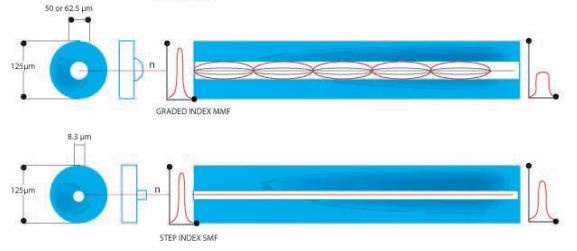Fiber Optic Technology offers numerous benefits compared to traditional Copper Cable. In order to understand the benefits, it is pertinent to knowing the differences between these Fiber Optic Cables and essentially, how they could help or harm the data transmission for your business.
The following article will explain the differences between both single-mode and multi-mode Fiber Optic Cables and how they can be utilized to improve bandwidth and signal communication.
Single-Mode Fiber Optic Cable:
The single-mode cable core is 8 to 9 microns which is about 10th of a human hair and uses a laser to transmit one light down the core of the cable. The core has only one refractive index to carry the light signal and the number of light reflections created as the light passes through decreases. This allows the AV signal to carry over great distances.
A key benefit is a greater bandwidth than multimode fiber, but it requires a light source with a narrow width and there is some dispersion over great distances.
This Fiber Optic Cable is typically used for companies that require long distances and a higher bandwidth such as: Campuses, Universities and CATV Companies, and much more.
Multi-Mode Fiber Optic Cable:
The multi-mode core of a Fiber Optic Cable is larger and can transfer more light. Typical multi-mode fiber core diameters are 50-to-100 microns in size. This fiber uses an LED or VCSEL source to transmit the light signals, and gives high bandwidth at high speeds over short distances compared to the single-mode.
A multi-mode core is set up with multiple rings with different refractive light indexes. These rings allow the light to travel over longer distances without loss of continuity of light, essentially creating the ability for more data to pass through at a given time. However, these signals can become compromised if the distance is increased too much.
This Fiber Optic Cable is ideal for shorter distance installations. Such as: Data and A/V applications in Local Area Networks (LANs).

How do I know which one to choose?
Great question. Ultimately it comes down to what is needed for the type of application it's being used for, and the length and bandwidth of the signal that needs to be transmitted.
Multi-mode fibers and single-mode fibers can carry the same type of signal, but multi-mode fibers will carry signals at a shorter distance than single-mode fibers. Depending on the type of signal bandwidth multi-mode fibers can handle lengths up to a few thousand feet and single-mode up to a few miles.
If you have questions about if Fiber Optic Cables are right for your organization, check out West Penn Wire's Fiber Optics Cable Guide. We can help learn more about low voltage cable solutions that improve uptime, maintain security, and help improve user access email us at Sales@westpennwire.com or call 800-245-4964.


